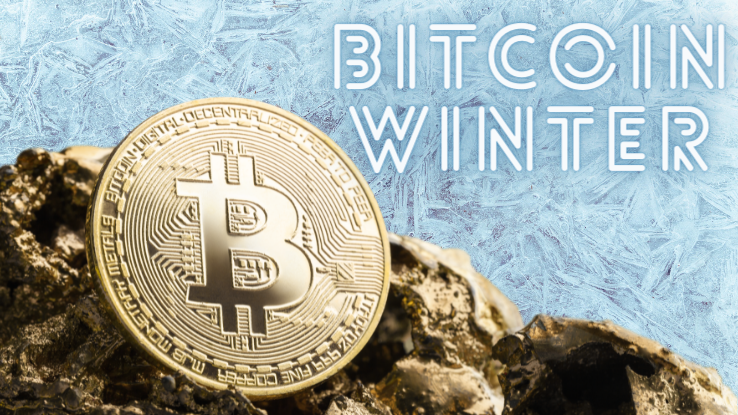Never Did Think That It Ever Would Happen Again

Like the stock market, the crypto market can be volatile — and that's often part of the appeal. Prices can skyrocket overnight, greatly increasing the value of the investment you made, and at other times they can crash, leaving you wishing that a surge would follow up quickly. If you're someone who wants to make money in the long run (or lose as little money as possible), it would be great if you could know when these upturns and downswings were about to take place. You could make sure that, as time goes on, your investments don't take the nosedives that less-savvy investors might face.
While we're still a ways off from inventing a crystal ball that tells us the right times to invest and sell, we do have the ability to recognize certain patterns in the performance and value of cryptocurrency — to the point that these performance periods are now getting their own names. The point in time when cryptocurrency may be facing a market crash or steep decline in value is now known as a Bitcoin winter or crypto winter. Fortunately, we may be able to use findings about crypto winters to make better-informed investing decisions. Take a look at the basics of this phenomenon to get started — and find out whether one might be on the horizon.
A Bitcoin winter occurs when the price of Bitcoin continues remains at a low level for an extended period of time, which can cause significant losses for Bitcoin traders. Its name comes in part from looking at the historic performance of Bitcoin — and the fact that, during wintertime in years past, the cryptocurrency's value plummeted. You can also think about it in terms of a nuclear winter, or the potential destruction of a nuclear blast leading to overall cooling of the planet. In the same way, a Bitcoin market crash leads to overall "cooling" of the cryptocurrency's value for a period of time.
An excellent example of a Bitcoin winter happened during 2018 when Bitcoin's value dropped 65% between January and February of that year. The actual price fell below $4,000, which was equal to an 80% decline from its peak value in December of 2017. This crash was preceded by a bubble, and the market took a while to recover — but was seemingly stable as values rose once more. That's what a Bitcoin winter is in a nutshell. But, of course, there's a lot more that happens behind the scenes of the crash.
Why Would Bitcoin Winters Be Predictable?

Various crypto experts have analyzed past Bitcoin winters in an effort to draw conclusions about whether traders should start preparing for another possible decline. They concluded that the Bitcoin market has a four-year cycle, and each cycle has four distinct phases.
The first phase is known as the exponential highs phase. During this period investors are buying Bitcoin at higher prices due to market trends and good publicity. The previous recovery phase has ended, and the cryptocurrency is enjoying renewed interest and perceived stability. This can often last up to 12 months. Eventually, investors' buying behavior pushes the value of Bitcoin to increasingly high prices as more people clamor to invest while prices rise.
The second phase is called the correction phase. During this period traders tend to shed the excessive optimism towards the market that they held during the exponential highs phase. As a result, Bitcoin's value begins to even out and start dropping.
The accumulation phase follows correction. As the price begins dropping, bargain investors begin to accumulate Bitcoin at seemingly discounted prices. During this phase, the value often plummets and hits a low, where it begins to level out and stabilize.
The final segment of the cycle is known as the recovery and continuation phase. Demand for Bitcoin increases, and prices begin to rise once more. Investors find renewed interest in buying instead of selling because of the perceived stability and increases in value that accompany this phase.
Bitcoin investments are a rollercoaster ride — the price unpredictably rises and drops constantly. In December 2020, the value Bitcoin hit $20,000 for the first time. It continued to grow until April 2021; the record high was $63,375. However, it then fell to under $30,000 in June of 2021 and eventually went back above $50,000 in August 2021.
During that time, Bitcoin received bad publicity, which can contribute to crypto winters. For example, between December 2020 and August 2021, Tesla stopped accepting cryptocurrency payments. The Chinese government introduced crypto trading and mining sanctions. UK banks blocked payments to crypto exchanges. And crypto hackers stole $600 million to prove how vulnerable cryptocurrency is. All of the above contributed to the decline of the Bitcoin peak. And because the market is unregulated, traders must always be prepared for another potential fall.
What to Do During a Bitcoin Winter

If the cycle continues, traders will inevitably face future Bitcoin winters. There are a couple of things you can do to prepare yourself and your portfolio for the decline, however.
Stack More Bitcoin
Should you invest during a Bitcoin crash? Possibly. You can take advantage of low prices, which is a smart strategy, but it's all about timing. When it comes to cryptocurrency, you should work continually to diversify your portfolio. A Bitcoin winter is an ideal time to make that happen at a relatively low price.
Stay Motivated for New Opportunities
New opportunities will still come along, even if you decide to wait it out. Take the time to do some unbiased evaluating of your cryptocurrency portfolio. It's time to weed out those coins you bought through pure speculation that are unlikely to bring any value. A crypto winter is a perfect time to analyze which of your investments work and which don't.
Get More Active in Decentralized Finance (DeFi)
Even during a Bitcoin winter, cryptocurrency that operates using decentralized finance, such as Ethereum, can show double-digit growth. DeFi doesn't rely on a third party to execute financial transactions. Instead, it gives you more control and transparency over your currency. However, uncertainty remains one of the biggest DeFi challenges. If you're thinking about investing in DeFi currencies, doing plenty of research is an absolute must.
Pay Attention to Crypto Cycles
During a crypto winter, you can analyze what happened in the past and look at the ways various traders responded to the crash. Because the market is relatively young, there's no foolproof strategy to adopt during this type of crash. It's essential to do your research and try out new investment strategies before, during and after the market drops — or, at the very least, find out how certain strategies worked for others.
Is a Bitcoin Winter Coming?
In diving deeper into data on the four-year cycle, Bitcoin analysts were able to predict the next crash. Historically, the biggest crashes occurred in 2013 and 2017. With that in mind, experts predicted that 2021 could be the year the market saw another decline.
But with Bitcoin maturing and larger entities entering the market, is the four-year cycle still relevant? 2021 has been an eventful year for the market, with altcoin investments rising substantially. The market is switching from seeing an influx of short-term traders to seeing more of those who are looking to invest long term. But, ultimately, the unpredictability of Bitcoin's stability could still result in another crypto winter occurring in late 2021 or early 2022 — highlighting the point that it's vital to be prepared, even if the winter doesn't materialize when we think itt might this winter.
Source: https://www.askmoney.com/investing/what-is-bitcoin-winter?utm_content=params%3Ao%3D1465803%26ad%3DdirN%26qo%3DserpIndex
0 Response to "Never Did Think That It Ever Would Happen Again"
Postar um comentário